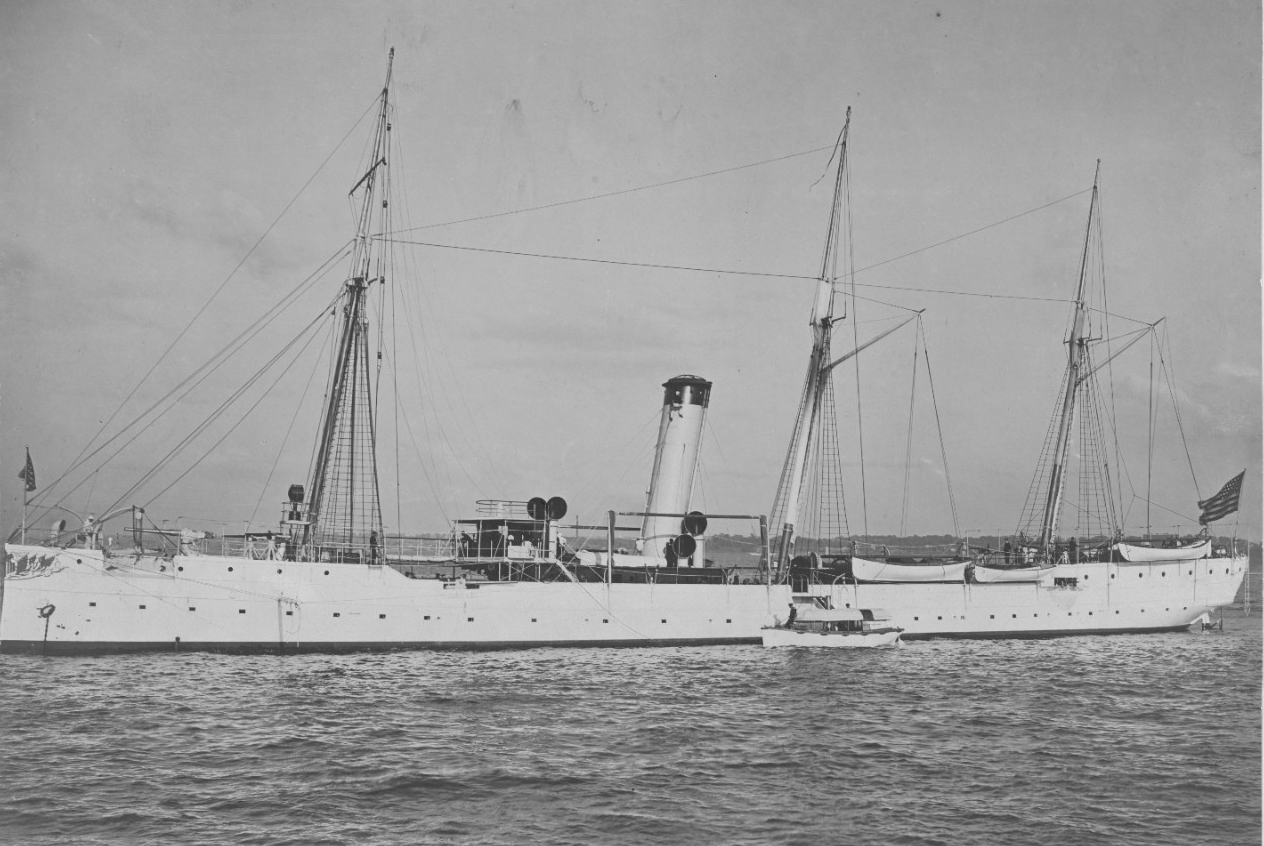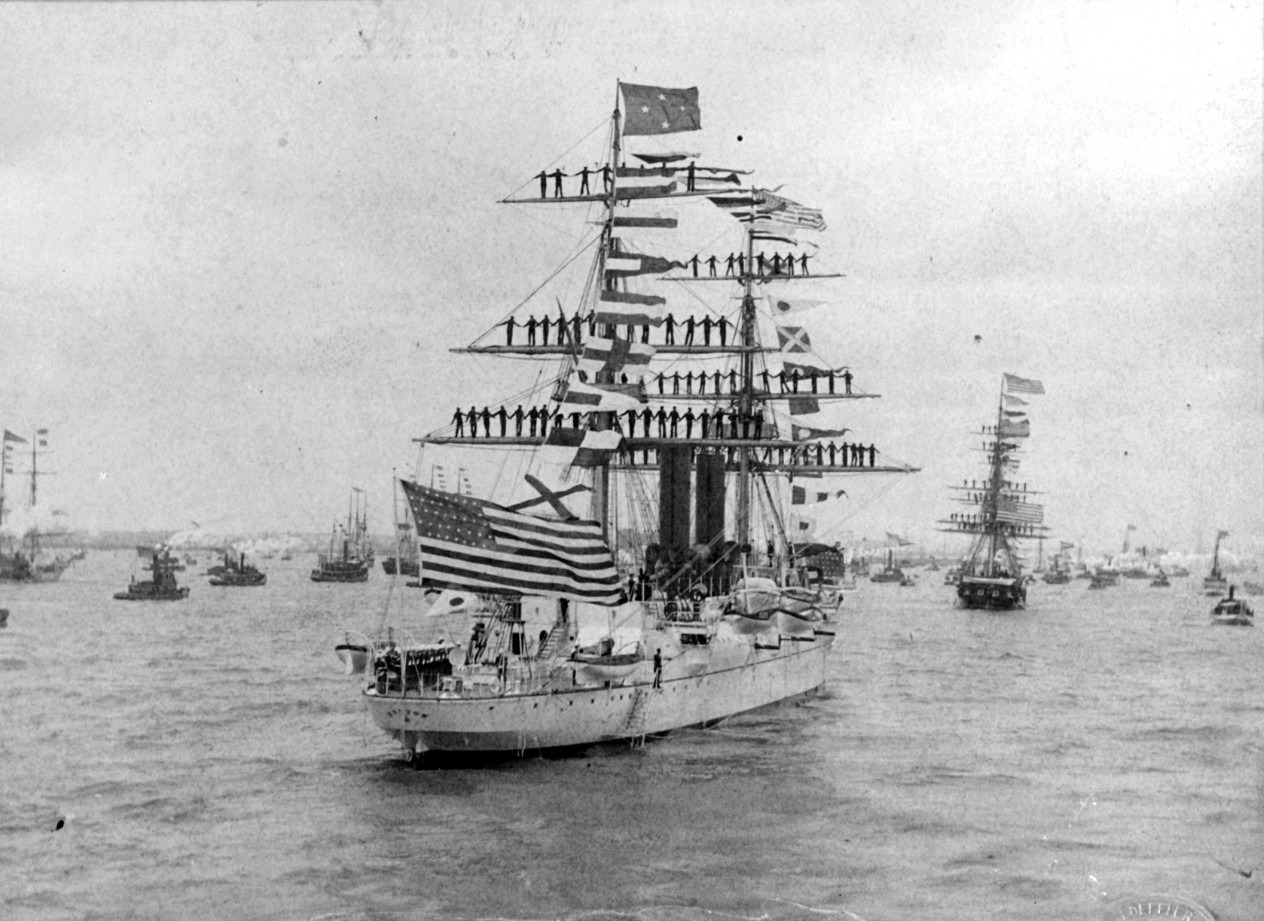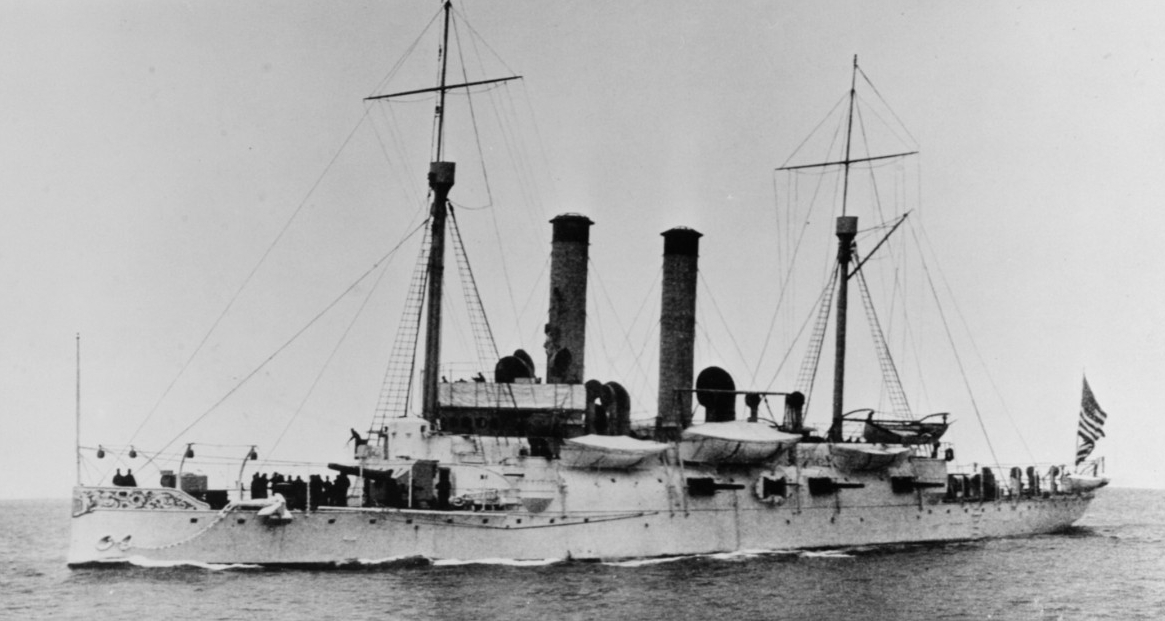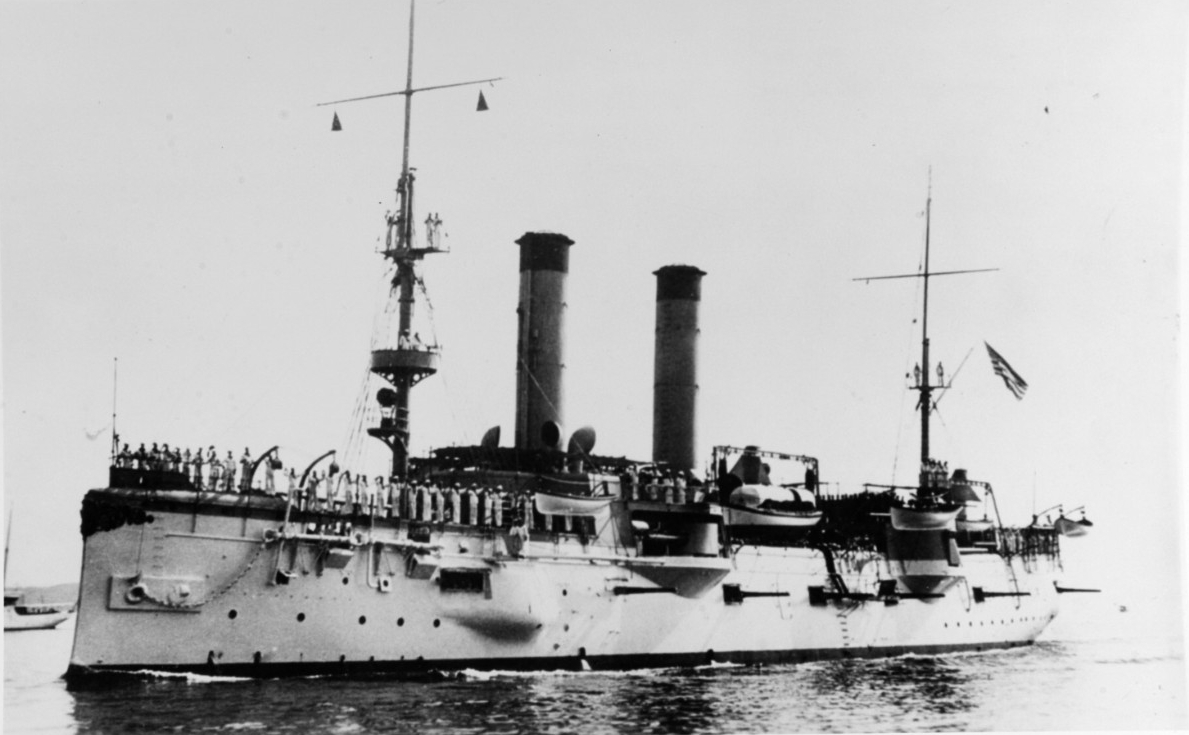The Steel Navy
USS Dolphin (PG-24) was the first of the four ABCD ships that were either converted or built in the 1880s with steel hulls and the latest in steam-propulsion technology. The successful conversion of Dolphin was a stepping stone for the construction of three larger steel-hulled, steam-propelled ships—Atlanta, Boston, and Chicago (NH 54532).
On 3 March 1883, after nearly two decades of neglect following the Civil War, the United States began a period of naval modernization when Congress authorized the construction of the country’s first steel-hulled, steam-propelled warships. Known as the “ABCD” ships, Atlanta, Boston, Chicago, and Dolphin (PG-24) were the first built (converted in Dolphin’s case) during the U.S. Navy’s transition from wood and sail to steel and steam. The new ships, as part of the so-called “New Navy” initiative, were hybrids of old and new technology. They featured hulls constructed of steel with relatively powerful steam engines but were also capable of operating under sail. The first of the ships, Dolphin, commissioned on 8 December 1885, was originally built to be a dispatch vessel, but after it was successfully converted, Dolphin was a stepping stone in the construction of the three larger steel-hulled, steam-powered protected cruisers (Atlanta, Boston, and Chicago). Although some naval officers were skeptical about coal-fired power because they saw it as dirty, unreliable, and, most importantly, expensive, they also felt it diminished the teamwork that was built upon operating a sailing vessel. However, over time, masts would be removed in favor of the much more powerful steam engines. Although the ABCD ships were already deemed obsolete by the time they were commissioned, they paved the way for more modern warships with the construction of second-class battleships such as Maine (commissioned in 1895) that were experimental, yet considered state-of-the-art at the time. Over the next few decades, a significant relationship was formed between the United States steel industry and the Navy, resulting in a series of technological advances that revitalized American sea power. This was highlighted by actions during the Spanish-American War and by naval enthusiast President Theodore Roosevelt’s Great White Fleet, which circumnavigated the globe with 16 steel warships from 1907 to early 1909. During the Navy’s era of steel battleship construction, which spanned nearly six decades, 59 steel battleships of 23 different classes were constructed (another 20 battleships and battle cruisers were begun or planned, but not completed). The last battleship commissioned was USS Missouri (BB-63) in 1944. Aside from several periods in reserve, it remained active until 1992.
Protected cruiser Boston dressed with flags and manning its yards during the Centennial Naval Parade in New York Harbor, 29 April 1889 (centennial of George Washington's first inauguration). The four-star flag of Admiral David D. Porter is flying from its mainmast peak. Boston was the third protected cruiser commissioned of the first four ships in the transition from wood and sail to steel and steam (NH 416).
How It Began
Prior to the commissioning of the ABCD ships, the Navy was in a state of decline, still exhausted by the Civil War and neglected by a country preoccupied with reconstruction and westward expansion. At the time, other countries, were experimenting with iron and steel ship hulls and improved steam-propulsion technology. By the 1880s, the U.S. Navy was outclassed by numerous navies from around the world and was seemingly content with the undemanding mission of showing the flag in foreign ports with its Civil War fleet of gunboats and ironclads. In 1882, the Navy’s inventory consisted of just 14 ironclads (mostly Civil War–era monitors) and a few wooden sailing vessels. The most powerfully armed vessels in the depleted American fleet were armed with nothing more powerful than five-inch smoothbore guns. The lack of modernization was partly a byproduct of an ongoing debate about what the Navy’s post-war role should be and what types of ships, if any, should be built. Many Americans who had lived through the Civil War wanted nothing more to do with military conflicts, and some felt that strong fortifications would be enough to protect America’s coasts without getting entangled in foreign conflicts.
Beginning in 1881, Secretary of the Navy William H. Hunt assembled a naval advisory board to try to address the state of the Navy. The 15 members of the board felt that the Navy should begin a new construction program, but they disagreed over whether the new ships should be sail- or steam-driven, what kind of armament they should carry, and whether their hulls should be made of iron or steel. Though it never reached a full consensus, the board recommended that Congress set aside $30 million for the construction of 21 new vessels. The House Naval Affairs Committee subsequently rejected the proposal as too costly. Another recommendation was to buy a few steel-hulled ships from Britain, like many other countries were doing at the time. However, national pride and self-reliance led to the proposal being rejected. Also rejected was the idea of purchasing ship plans from another country for an American shipyard to build. In any event, the 19 September 1881 assassination of President James Garfield put all initiatives on hold, and incoming President Chester A. Arthur replaced Hunt with his own pick for Secretary of the Navy, William E. Chandler. Chandler was also a proponent of modernization and successfully lobbied Congress to move forward with a drastically scaled-back construction program. On 5 August 1882, Congress authorized the construction of two steel warships without appropriating any funds for them, insisting funding would come from somewhere else within the existing budget. Although the two ships were never built, the lukewarm response put in motion the appropriations bill that would pass months later for the ABCD ships. Though construction was delayed numerous times by a series of setbacks, the ABCD ships announced to the rest of the world that the United States was intent on becoming a modern naval power.
Fate of the ABCD Ships
Atlanta
After Atlanta was commissioned on 19 July 1886, it joined the North Atlantic Squadron, with which it cruised the Atlantic coast, Gulf of Mexico, and the West Indies for about two years before joining the Squadron of Evolution. During the next three years, Atlanta steamed to Europe, the Mediterranean, Brazil, and the West Indies before rejoining the North Atlantic Squadron in September 1892. Over the next several years, Atlanta conducted routine voyages mostly along the eastern seaboard and South American coast, highlighted by the brief deployment of a landing party to protect American interests during a period of civil unrest at Boca del Toro, Colombia, in 1895. After it was placed in and out of commission several times, Atlanta served as a barracks ship for the Torpedo Flotilla at Norfolk, Virginia, and Charleston, South Carolina, before it was decommissioned in 1912.
Boston
Boston was commissioned at the New York Navy Yard on 2 May 1887. After a period of outfitting, Boston was dispatched to Livingston, Guatemala, to inquire about alleged cases of the mistreatment of American citizens by local military authorities. From there, it cruised to Haiti to protect American interests in that politically unstable nation. Boston returned to New York in November 1888, from where it patrolled mostly off the U.S. East Coast. On 30 September 1889, Boston was assigned to the Squadron of Evolution, primarily serving in European and Mediterranean waters. On 23 August 1890, it joined other U.S. Navy ships at New York for a ceremony honoring the late Capt. John Ericsson, creator of the United States’ first armored warship, Monitor, as his remains were embarked in Baltimore for the voyage back to Sweden, the nation of his birth. In October 1891, Boston rounded Cape Horn to the Pacific Ocean. After numerous port calls in Latin America, Boston arrived in San Diego on 26 April 1892, before heading north to San Francisco. After three months of repair, Boston steamed for the Hawaiian Islands, arriving on 24 August. During Boston’s extended stay, events occurred which led to the downfall of the Hawaiian monarchy. In January 1893, Boston sent a landing party ashore to protect American lives and interests. The upheaval ultimately led to the annexation of Hawaii by the United States five years later.
In September 1893, Boston departed Hawaii, arriving in San Francisco the following month. After it was decommissioned in November, Boston remained in ordinary until it was recommissioned in November 1895. In January 1896, Boston steamed to the Far East, arriving in Yokohama, Japan, on 25 February. For the next two years, Boston patrolled Asiatic waters, mostly around the Chinese, Korean, and Japanese coasts. At the beginning of 1898 and the onset of the Spanish-American War, Boston served at Chemulpo, Korea, as a station ship watching over American missionary and trading activities. The ship moved to Hong Kong in late February on the heels of Assistant Secretary of the Navy Theodore Roosevelt’s telegram to Admiral George Dewey ordering him to concentrate the Asiatic Squadron at Hong Kong for action against the Spanish fleet in the Philippines. During the Spanish-American War, Boston saw action with the Asiatic Squadron at the Battle of Manila Bay. Boston continued to serve in the Far East until the ship was decommissioned in San Francisco in 1899.
Boston was recommissioned in 1902 and served in the Pacific Squadron until it was converted to a freighter during World War I. It served as a receiving ship from 1918 to 1940. After that, Boston was renamed USS Despatch (IX-2) and served as a radio school until the end of 1945 before it was towed out to sea and sunk the following year.
Chicago
Chicago, the first U.S. Navy ship named for that city, was commissioned on 17 April 1889. Later that year, it departed Boston for Lisbon, Portugal, arriving 21 December. The protected cruiser served as flagship of the Squadron of Evolution in European and Mediterranean waters until 31 May 1890. After it returned to New York, Chicago operated along the U.S. East Coast and in the Caribbean until 1893. In June 1893, Chicago departed New York to cruise in European and Mediterranean waters as flagship of the European Station, returning to the United States in March 1895 and was subsequently decommissioned for several years. After it was recommissioned, it returned to European waters until 1903. On 17 November 1904, Chicago steamed for Valparaiso, Chile, arriving 28 December. While there, it served as flagship of the Pacific Station, operating off the west coasts of North and South America, in the Caribbean, and in Hawaiian waters. From 1908 until 1910, Chicago was assigned to the U.S. Naval Academy. The ship was reduced to the status of commissioned in reserve from 1910 to 1917 and was used by the Massachusetts and Pennsylvania militias. Chicago then served as a receiving ship and renamed USS Alton (IX-5) in 1928 before it was sold in 1936. It was lost later that year in the mid-Pacific while under tow.
Dolphin
Dolphin, the first of the ABCD ships, was originally built as a dispatch vessel that was converted during construction to a steel-hulled, steam-propelled ship. After it was commissioned, Dolphin cruised the eastern seaboard until February 1886. It then steamed around South America on its way to the Pacific Station for duty. It visited ports in Japan, Korea, China, Ceylon, India, Arabia, Egypt, Italy, Spain, and England, and the islands of Madeira and Bermuda, before arriving at New York on 27 September 1889, completing a round-the-world cruise. The following year, Dolphin went on a six-month cruise in the West Indies before it was assigned to the Squadron of Evolution. After going through periods of decommissioning and recommissioning, Dolphin served on blockade duty off Havana, Cuba, during the Spanish-American War. From 1899 until the outbreak of World War I, it served as a special dispatch ship for the Secretary of the Navy and often carried the President and other important officials and diplomats. During World War I, Dolphin was homeported at Key West, Florida, and operated in the Gulf of Mexico and the Caribbean to protect merchant shipping. On 16 October 1920, Dolphin served as flagship of the Special Service Squadron to represent the United States at the celebration of the 400th anniversary of the discovery of the Straits of Magellan. Dolphin was decommissioned on 8 December 1921.
*****






